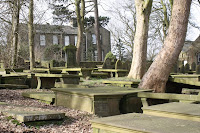

The excursions we organize for our Calvin class are not just trips into the idyllic English country side or to England’s most beautiful places. Yorkshire has a rich industrial past, and the first "dark satanic mills" were built in the steep valleys of West Yorkshire. Haworth, where the Brontë sisters lived for most of their lives in their father’s parsonage (fotos above), was perhaps a fairly remote place, at the edge of the Moors (certainly before the coming of the railway, today a scenic steam railway to the not-so-scenic city of Keighley, fotos below). But in 1830, Haworth already had a population of 3,000, and several mills. The living conditions in nineteenth-century Haworth must have been miserable, with dismal sanitary conditions and a high mortality rate, due to tuberculosis and cholera.
Not all mill owners were insensitive to the worker’s conditions. In 1853, multimillionair mill owner Titus Salt from Bradford decided to found the the nearby village of Saltaire. He built a gigantic mill in Italianate style, equipped it with the latest green technology (a smoke-reducing steam engine of his own patented design), and built a model village for his workers right next to it. Today, Salt’s Mill is no longer a working Mill, but it houses a museum, gallery, and several fancy shops, including an early music story. But the mill and the village (fotos) still stand as a monument to Salt’s Utopian vision, which, incidentally, proved to be financially profitable as well.
Our guide, Roger Clarke, dressed up as a nineteenth-century presbyterian minister, showed the Calvin College group around Saltaire’s United Reformed Church, quite an exuberant building for a Calvinist church. To the right, a bust of Titus Salt in one of the mill's galleries, which also contained paintings by David Hockney.
From West Yorkshire, coal was transported to the coast by canals, and later railroads. Many canals ended in Goole, where the coals vessels (called "tom puddings") were loaded onto larger ships. The Goole Waterways Museum preserves the memory of this recent past; the last tugboats pulled the tom puddings from West Yorkshire to Goole in the 1980s, when Thatcher closed down the British coal mining industry. Our excursion included a tugboat ride (the students had as much fun steering the boat as Kees and Thomas) and explanations by our expert guide, the former skipper of one of these tugboats.








No comments:
Post a Comment